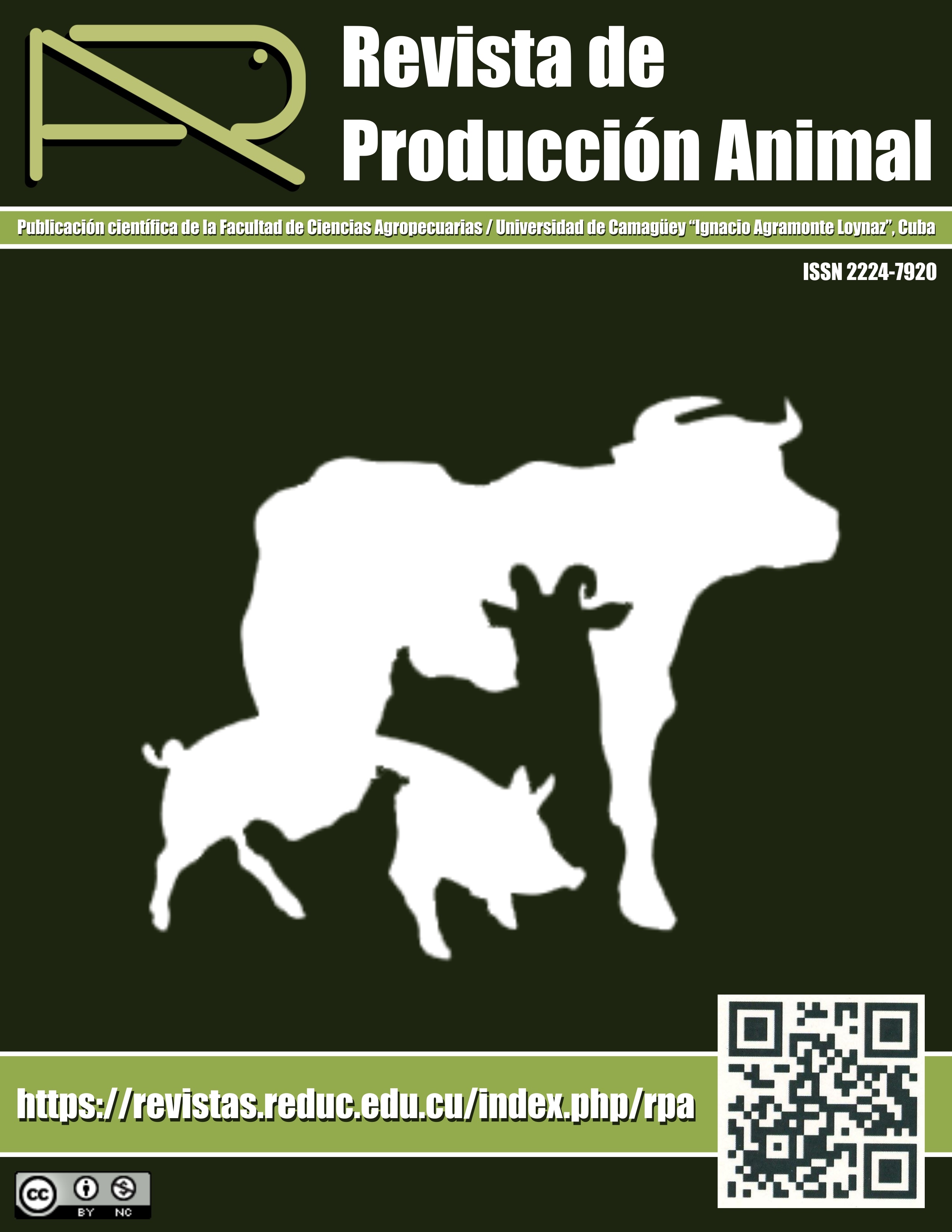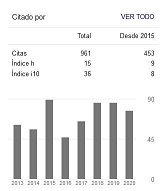Bacillus firmus: aplicaciones y potencialidades como probiótico en la acuicultura
Resumen
Antecedentes: En la actualidad, numerosas cepas bacterianas del género Bacillus se utilizan como probióticos para promover el crecimiento en organismos acuáticos cultivados, especialmente en estadios larvarios. Realizar una revisión sobre las diferentes aplicaciones de Bacillus firmus en la industria con énfasis en su uso como probiótico en la acuicultura. Desarrollo: B. firmus, es una bacteria beneficiosa ampliamente utilizada como nematicida en la protección de cultivos en la agricultura, en la biorremediación de ambientes contaminados, en la producción de enzimas y como probiótico en la acuicultura. Se destacan las potencialidades de su uso en el cultivo del camarón para el control de enfermedades y el manejo de la calidad del agua del estanque. Conclusiones: Sin embargo, no ha sido suficientemente investigado su mecanismo específico en el cultivo de camarones, aspecto que resulta de gran interés para poder explotar todos los beneficios que ofrece esta bacteria en este renglón de la economía.
Palabras claves: bacteria, camarón, cultivo, probióticos (Fuente: MESH)
Descargas
Citas
Aly, S. M., Abd-El-Rahman, A. M., John, G., & Mohamed, M. F. (2008). Characterization of some bacteria isolated from Oreochromis niloticus and their potential use as probiotics. Aquaculture, 277(1-2), 1-6. https://doi.org/10.1016/j.aquaculture.2008.02.021
Annamalai, N., Rajeswari, M., Sahu, S., & Balasubramanian, T. (2014). Purification and characterization of solvent stable, alkaline protease from Bacillus firmus CAS 7 by microbial conversion of marine wastes and molecular mechanism underlying solvent stability. Process Biochemistry, 49(6), 1012-1019. DOI:https://doi.org/10.1016/j.procbio.2014.03.007
Bachate, S. P., Nandre, V. S., Ghatpande, N. S., & Kodam, K. M. (2013). Simultaneous reduction of Cr(VI) and oxidation of As(III) by Bacillus firmus TE7 isolated from tannery effluent. Chemosphere, 90(8), 2273-2278. DOI:10.1016/j.chemosphere.2012.10.081
Baramee, S., Siriatcharanon, A.-k., Ketbot, P., Teeravivattanakit, T., Waeonukul, R., Pason, P., . . . & Phitsuwan, P. (2020). Biological pretreatment of rice straw with cellulase-free xylanolytic enzyme-producing Bacillus firmus K-1: Structural modification and biomass digestibility. Renewable Energy, 160, 555-563. DOI:https://doi.org/10.1016/j.renene.2020.06.061
Barathi, S., Karthik, C., S, N., & Padikasan, I. A. (2020). Biodegradation of textile dye Reactive Blue 160 by Bacillus firmus (Bacillaceae: Bacillales) and non-target toxicity screening of their degraded products. Toxicology Reports, 7, 16-22. DOI:https://doi.org/10.1016/j.toxrep.2019.11.017
Bueno, M. R., Cavalcanti, A., Melo, J., Olivo, J., & Zanin, G. (2014). Obtenção de ciclomaltodextrina-glucanotransferase em processo fermentativo por Bacillus firmus cepa 37 para produção de ciclodextrinas. Congreso brasileño de Ingeniería química. http://pdf.blucher.com.br.s3saeast1.amazonaws.com/chemicalengineeringproceedings/cobeq2014/0607-24743-176105.pdf
Corrales-Ramírez, L., Caycedo-Lozano, L., Gómez-Méndez, M., Ramos-Rojas, S., & Rodríguez-Torres, J. (2017). Bacillus spp: una alternativa para la promoción vegetal por dos caminos enzimáticos. Nova, 15, 46-65. https://repository.unad.edu.co/handle/10596/29823
Cuervo Lozada, J. P. (2010). Aislamiento y Caracterización de Bacillus spp como fijadores biológicos de nitrógeno y solubilizadores de fosfatos en dos muestras de biofertilizantes comerciales. https://repository.javeriana.edu.co/handle/10554/8434
d'Errico, G., Marra, R., Crescenzi, A., Davino, S. W., Fanigliulo, A., Woo, S. L., & Lorito, M. (2019). Integrated management strategies of Meloidogyne incognita and Pseudopyrenochaeta lycopersici on tomato using a Bacillus firmus-based product and two synthetic nematicides in two consecutive crop cycles in greenhouse. Crop Protection, 122, 159-164. DOI:https://doi.org/10.1016/j.cropro.2019.05.004
Dino, A., Brindha, R., Jayamuthunagai, J., & Bharathiraja, B. (2019). Biodegradation of aniline from textile industry waste using salt tolerant Bacillus firmus BA01. Engineering in Agriculture, Environment and Food, 12(3), 360-366. DOI:https://doi.org/10.1016/j.eaef.2019.04.003
El-Esawi, M. A., Alaraidh, I. A., Alsahli, A. A., Alamri, S. A., Ali, H. M., & Alayafi, A. A. (2018). Bacillus firmus (SW5) augments salt tolerance in soybean (Glycine max L.) by modulating root system architecture, antioxidant defense systems and stress-responsive genes expression. Plant Physiology and Biochemistry, 132, 375-384. DOI:https://doi.org/10.1016/j.plaphy.2018.09.026
FAO. (2020). El estado mundial 2020 de la pesca y la acuicultura. In. DOI:https://doi.org/10.4060/ca9231es
Fatmawati, N. V., Ketbot, P., Phitsuwan, P., Waeonukul, R., Tachaapaikoon, C., Kosugi, A., . . . & Pason, P. (2021). Efficient biological pretreatment and bioconversion of corn cob by the sequential application of a Bacillus firmus K-1 cellulase-free xylanolytic enzyme and commercial cellulases. Applied Microbiology and Biotechnology, 105(11), 4589-4598. https://link.springer.com/article/10.1007/s00253-021-11308-9
Gawande, B. N., Goel, A., Patkar, A. Y., & Nene, S. N. (1999). Purification and properties of a novel raw starch degrading cyclomaltodextrin glucanotransferase from Bacillus firmus. Appl Microbiol Biotechnol, 51, 504-509. https://link.springer.com/article/10.1007/s002530051424
Gawande, B. N., Singh, R. K., Chauhan, A. K., Goel, A., & Patkar, A. Y. (1998). Optimization of cyclomaltodextrin glucanotransferase production from Bacillus firmus. Enzyme and Microbial Technology, 22(4), 288-291. DOI:https://doi.org/10.1016/S0141-0229(97)00184-1
Geng, C., Nie, X., Tang, Z., Zhang, Y., Lin, J., Sun, M., & Peng, D. (2016). A novel serine protease, Sep1, from Bacillus firmus DS-1 has nematicidal activity and degrades multiple intestinal-associated nematode proteins. Scientific reports, 6(1), 1-12. https://www.nature.com/articles/srep25012
Huang, M., Bulut, A., Shrestha, B., Matera, C., Grundler, F. M., & Schleker, A. S. S. (2021). Bacillus firmus I-1582 promotes plant growth and impairs infection and development of the cyst nematode Heterodera schachtii over two generations. Scientific reports, 11(1), 1-15. https://www.nature.com/articles/s41598-021-93567-0
Jamali, H., Reza , R., Imani, A., Isari, A., & Abdollahi, D. (2015). Use of probiotic Bacillus spp. in rotifer (Brachionus plicatilis) and Artemia (Artemia urmiana) enrichment: Effects on growth and survival of pacific white shrimp, Litopenaeus vannamei, larvae. Probiotics & Antimicro. Prot., 7, 118-125. DOI:10.1007/s12602-015-9189-3
Keung, Feng, G., Peiyuan, Q., & Wen-Xiong, W. (2008). Influences of metal-ligand complexes on the cadmium and zinc biokinetics in the marine bacterium, Bacillus firmus. Environmental Toxicology & Chemistry, 27(1), 131-137. DOI:10.1897/07-048.1
Kuebutornye, F., & Abarike, E. (2019). A review on the application of Bacillus as probiotics in Aquaculture. Fish and Shellfish Immunology. DOI:https://doi.org/10.1016/j.fsi.2019.02.010
Lagunas, J., Zavaleta, E., Osada, S., Aranda, S., Luna, I., & Vaquera, H. (2001). Bacillus firmus como agente de control biológico de Phytophthora capsici Leo. en jitomate (Lycopersicon esculentum Mill.). Revista Mexicana de Fitopatología, 19(1), 57-65. https://www.redalyc.org/pdf/612/61219108.pdf
Li, E., Xu, C., Wang, X., Wang, S., Zhao, Q., Zhang, M., . . . & Chen, L. (2018). Gut Microbiota and its Modulation for Healthy Farming of Pacific White Shrimp Litopenaeus vannamei. Reviews in Fisheries Science & Aquaculture, 26(3), 381-399. DOI:10.1080/23308249.2018.1440530
Li, M., Xi, B., Qin, T., Chen, K., Ren, M., & Xie, J. (2019). Indigenous AHL‐degrading bacterium Bacillus firmus sw40 affects virulence of pathogenic Aeromonas hydrophila and disease resistance of gibel carp. Aquaculture Research, 50(12), 3755-3762. https://onlinelibrary.wiley.com/doi/abs/10.1111/are.14338
lozada, J. P. C. (2010). Aislamiento y caracterizacion de bacillus spp comofijadores biologicos de nitrogeno y solubilizadores de fosfatos en dos muestras de biofertilizantes comerciales. (Trabajo de grado), Pontificia Universidad JAVERIANA, Bogotá. https://repository.javeriana.edu.co/handle/10554/54683
Mahat, M. K., Illias, R. M., Rahman, R. A., Rashid, N. A. A., Mahmood, N. A. N., Hassan, O., . . . & Kamaruddin, K. (2004). Production of cyclodextrin glucanotransferase (CGTase) from alkalophilic Bacillus sp. TS1-1: media optimization using experimental design. Enzyme and Microbial Technology, 35(5), 467-473. DOI:https://doi.org/10.1016/j.enzmictec.2004.07.008
Mahmood, F., Shahid, M., Hussain, S., Haider, M. Z., Shahzad, T., Ahmed, T., . . . Khan, M. B. (2020). Bacillus firmus strain FSS2C ameliorated oxidative stress in wheat plants induced by azo dye (reactive black-5). 3 Biotech, 10(2), 1-13. https://link.springer.com/article/10.1007/s13205-019-2031-y
Mazzer, C., Ferreira, L. R., Rodella, J. R. T., Moriwaki, C., & Matioli, G. (2008). Cyclodextrin production by Bacillus firmus strain 37 immobilized on inorganic matrices and alginate gel. Biochemical Engineering Journal, 41(1), 79-86. DOI:https://doi.org/10.1016/j.bej.2008.03.010
Moon, S. H., & Parulekar, S. J. (1993). Some observations on protease production in continuous suspension cultures of Bacillus firmus. Biotechnology and bioengineering, 41(1), 43-54. https://pubmed.ncbi.nlm.nih.gov/18601244/
Moriwaki, C., Costa, G., Pazzetto, R., Moraes, F., Portilho, M., & Matioli, G. (2007). Production and characterization of a new cyclodextrin glycosyltransferase from Bacillus firmus isolated from Brazilian soil. Process Biochemistry, 42(10), 1384-1390. DOI:https://doi.org/10.1016/j.procbio.2007.07.007
Pazzetto, R., de Oliveira Delani, T. C., Fenelon, V. C., & Matioli, G. (2011). Cyclodextrin production by Bacillus firmus strain 37 cells immobilized on loofa sponge. Process Biochemistry, 46(1), 46-51. DOI:https://doi.org/10.1016/j.procbio.2010.07.008
Peñalosa-Martinell, D., Vela-Magaña, M., Ponce-Díaz, G., & Araneda Padilla, M. E. (2020). Probiotics as environmental performance enhancers in the production of white shrimp (Penaeus vannamei) larvae. Aquaculture, 514, 734491. DOI:https://doi.org/10.1016/j.aquaculture.2019.734491
Pérez-Chabela, M. d. L., Alvarez-Cisneros, Y., M., Soriano-Santos, J., & Pérez-Hernández, M. A. (2020). Los probióticos y sus metabolitos en la acuicultura. Una Revisión. Hidrobiológica, 30, 93-105. https://scholar.archive.org/work/anrwij65w5drpl346rnunw5rr4/access/wayback/https://hidrobiologica.izt.uam.mx/index.php/revHidro/article/download/1394/1087/
Ramírez-Fernández, P. E. V. A., Ernesto Evaristo; Miranda, Ricardo. (2018). Estudio estratégico para el desarrollo sostenible de la acuicultura de agua dulce en Camagüey. Producción animal, 30(1), 58-65. http://www.scielo.org.mx/scielo.php?pid=S018888972020000100093&script=sci_abstract&tlng=en
Ruiz-Toquica, J. S., Becerra-Real, L. M., & Villamil-Díaz, L. M. (2020). Effect of Bacillus firmus C101 on the growth of Litopenaeus vannamei Boone (White Shrimp) post-larvae, and Brachionus plicatilis s.s. Müller (Rotifer). Boletín de Investigaciones Marinas y Costeras - INVEMAR, 49, 63-80. https://www.scielo.org.co/scielo.php?script=sci_arttext&pid=S012297612020000100063
Salehizadeh, H., & Shojaosadati, S. A. (2003). Removal of metal ions from aqueous solution by polysaccharide produced from Bacillus firmus. Water Research, 37(17), 4231-4235. DOI:https://doi.org/10.1016/S0043-1354(03)00418-4
Seo, J.-H., & Lee, S.-P. (2004). Production of fibrinolytic enzyme from soybean grits fermented by Bacillus firmus NA-1. Journal of Medicinal Food, 7(4), 442-449. https://www.liebertpub.com/doi/abs/10.1089/jmf.2004.7.442
Sinha, P., & Pandey, A. (2014). Biohydrogen production from various feedstocks by Bacillus firmus NMBL-03. International Journal of Hydrogen Energy, 39(14), 7518-7525. doi:https://doi.org/10.1016/j.ijhydene.2013.08.134
Sun, Y., Song, X., Liu, F., Li, Y., & Huang, J. (2013). Isolation and identification of Bacillus sp. and evaluation of its effect on WSSV disease resistance in Litopenaeus vannamei. Journal of Fisheries of China, 37(4), 574-583. https://www.cabdirect.org/cabdirect/abstract/20133235778
Toledo, A., Castillo, N. M., Carrillo, O., & Arenal, A. (2018). Probióticos: una realidad en el cultivo de camarones. Artículo de revisión. Revista de Producción Animal, 30(2), 57-71. https://www.scielo.sld.cu/scielo.php?script=sci_arttext&pid=S2224-79202018000200009
Tseng, M.-J., Yap, M.-N., Ratanakhanokchai, K., Kyu, K. L., & Chen, S.-T. (2002). Purification and characterization of two cellulase free xylanases from an alkaliphilic Bacillus firmus. Enzyme and Microbial Technology, 30(5), 590-595. DOI:https://doi.org/10.1016/S0141-0229(02)00018-2
Valdes Vaillant, Y., Mejías Palmero, J., Corrales Barrios, Y., López Rodríguez, M., Hernández Sariego, T., Arenal Cruz, A., & & Bossier, P. (2020). Efecto de prebióticos y probióticos en la expresión y actividad de fenoloxidasa en camarones Penaeus: Meta-análisis. Agrisost, 26(3), 1-16. https://biblio.ugent.be/publication/8753279
Xiong, J., Zhou, Q., Luo, H., Xia, L., Li, L., Sun, M., & Yu, Z. (2015). Systemic nematicidal activity and biocontrol efficacy of Bacillus firmus against the root-knot nematode Meloidogyne incognita. World Journal of Microbiology and Biotechnology, 31(4), 661-667. https://link.springer.com/article/10.1007/s11274-015-1820-7
Zlotnikov, A. K., Shapovalova, Y. N., & Makarov, A. A. (2001). Association of Bacillus firmus E3 and Klebsiella terrigena E6 with increased ability for nitrogen fixation. Soil Biology and Biochemistry, 33(11), 1525-1530. https://www.sciencedirect.com/science/article/pii/S0038071701000700
Derechos de autor 2022 Revista de Producción Animal

Esta obra está bajo licencia internacional Creative Commons Reconocimiento-NoComercial 4.0.
Los autores de los artículos publicados en RPA retienen los derechos de autor de su trabajo, de marca y patente, y también sobre cualquier proceso o procedimiento descrito en el artículo, así como a compartir, copiar, distribuir, ejecutar y comunicar públicamente el artículo publicado en la RPA o cualquier parte de aquel siempre que indiquen la fuente de publicación (autores del trabajo, revista, volumen, número y fecha), pero están de acuerdo en que la revista publique los trabajos bajo una licencia Creative Commons.
![]() Licencia Attribution-NonCommercial 4.0 International (CC BY-NC 4.0)
Licencia Attribution-NonCommercial 4.0 International (CC BY-NC 4.0)






































